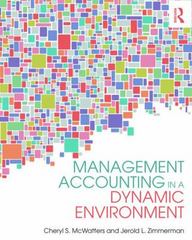Question
7. Classify each of the following costs of a mobile home manufacturer using these symbols: DM - Direct Materials, DL = Direct Labor, MO =
7. Classify each of the following costs of a mobile home manufacturer using these symbols: DM - Direct Materials, DL = Direct Labor, MO = Manufacturing Overhead, and O = Other. a. Sheet aluminum. h. Wages of assemblers. b. Wages of drill press operators. i. Salaries of inspectors. c. Oil for factory machines. j. Lumber. d. Salary of company president. k. Factory accountant's salary. e. Factory supervisors' salaries. l. Executive office rent. f. Sales salaries. m. Nails and staples. g. Factory building insurance. n. Purchasing agent's salary. 8. Identify by letters the costs in the preceding question that would be classified as product costs and as period costs. Product Costs Period Costs 9. Selling and administrative costs are often called __________ costs and are __________ as incurred. 10. If Cost of Goods Manufactured is $306,790, beginning Work in Process Inventory, $25,000, and Cost to Manufacture, $300,000, the ending Work in Process Inventory balance is $__________. 11. Using the same data as in the preceding question, with Direct Labor costing $140,000 and Direct Materials costing $90,000, Manufacturing Overhead is $__________. 12. The entry to assign manufacturing overhead to production includes a debit to __________ __________ __________ __________ and a credit to __________ __________. 13. The two major types of cost accumulation systems are the __________ __________ system and the __________ __________ system. A __________ __________ system would be employed in accounting for the costs of constructing an apartment building. 14. The three elements of manufacturing cost are __________ __________, __________ __________, and __________ __________. 15. Assume the following information relates to the Q Company for the Month of May: Job No. 306 Job No. 307 Job No. 308 In process - May 1: Materials $30,000 $15,000 $0 Labor 45,000 30,000 0 Overhead 67,500 45,000 0 Costs added in May: Materials 7,500 30,000 30,000 Labor 30,000 30,000 60,000 Overhead ? ? ? Actual overhead costs incurred in May amounted to $172,500. Job Nos. 306 and 307 were completed and transferred out in May. Overhead is applied using a predetermined overhead rate. From the above data compute: a. The cost of the May 1 work in process inventory b. The total amount of overhead assigned to production in May assuming no change in the overhead rate employed. c. The cost of Job No. 306 when completed. d. The cost of the goods completed and transferred. e. The cost of the May 30 work in process inventory. 16. In reference to the preceding problem, the balance in the Manufacturing Overhead account is $__________, and overhead is __________ (overapplied / underapplied). 17. A __________ __________ is a measure of activity, such as machine-hours or computer time, that is a causal factor in the incurrence of costs in an organization. 18. Generally speaking, manufacturing overhead is applied to production by means of a __________ __________ __________, which is computed under the general formula of dividing __________ __________ __________ by some measure of the __________ __________ __________. 19. Common bases or levels of activity on which overhead rates are often based include __________ __________ __________ __________ __________, __________ __________-__________, and __________-__________. 20. Manufacturing overhead is __________ when the amount of overhead applied to production exceeds the amount of overhead incurred in a period. When the reverse is true, overhead is __________. 21. Assume that budgeted total overhead is $1,000,000 and that budgeted machine-hours are 100,000 for the coming period. Actual overhead was $1,006,000 and actual machine-hours were 102,000. Overhead for the period is __________ (overapplied / underapplied) by $_________. 22. One difference between the income statements unders the two methods, absorption and variable costing, is that absorption costing focuses on gross __________, while variable costing focuses on __________ margin. 23. Under __________ __________, all __________ manufacturing overhead costs are charged off during the period rather than being deferred and carried forward to the next period as part of inventory cost. 24. The only differences between absorption costing and variable costing are the treatment of __________ __________ __________ and the __________ __________ preparation. 25. __________ and __________ expenses are treated as __________ costs under both absorption and variable costing methods. 26. Variable __________ and __________ expenses are not part of product costs under either absorption or variable costing methods.
Step by Step Solution
There are 3 Steps involved in it
Step: 1

Get Instant Access to Expert-Tailored Solutions
See step-by-step solutions with expert insights and AI powered tools for academic success
Step: 2

Step: 3

Ace Your Homework with AI
Get the answers you need in no time with our AI-driven, step-by-step assistance
Get Started


